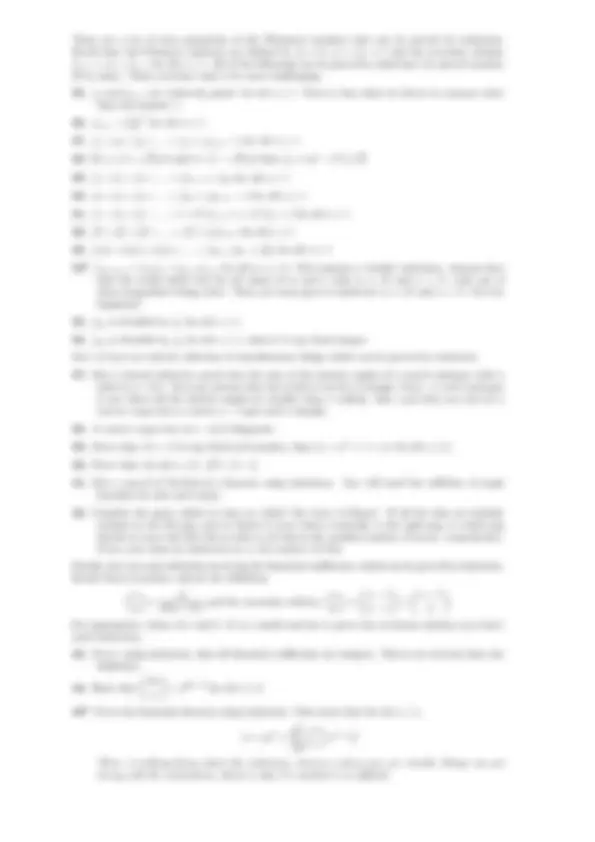



Study with the several resources on Docsity

Earn points by helping other students or get them with a premium plan


Prepare for your exams
Study with the several resources on Docsity

Earn points to download
Earn points by helping other students or get them with a premium plan
Community
Ask the community for help and clear up your study doubts
Discover the best universities in your country according to Docsity users
Free resources
Download our free guides on studying techniques, anxiety management strategies, and thesis advice from Docsity tutors
A collection of statements that can be proved using the method of mathematical induction. The statements range from easy to difficult, with some marked with an asterisk indicating greater challenge. The document also includes problems involving series, divisibility, and the fibonacci numbers.
Typology: Study notes
1 / 2

This page cannot be seen from the preview
Don't miss anything!


Induction problems can be hard to find. Most texts only have a small number, not enough to give a student good practice at the method. Here are a collection of statements which can be proved by induction. Some are easy. A few are quite difficult. The difficult ones are marked with an asterisk. I would not ask you to do a problem this hard in a test or exam.
2 n(n^ + 1)
n^2 (n + 1)^2
4* 14 + 2^4 + 3^4 +... + n^4 =
n(n + 1)(2n + 1)(3n^2 + 3n − 1)
5* 15 + 2^5 + 3^5 +... + n^5 =
12 n
(^2) (n + 1) (^2) (2n (^2) + 2n − 1)
Is there a pattern in this? Consider the following.
∑^ n r=
r =
n(n + 1)
∑^ n r=
r(r + 1) =
n(n + 1)(n + 2)
∑^ n r=
r(r + 1)(r + 2) =
n(n + 1)(n + 2)(n + 3)
Can you see how the results from numbers 6-8 could be used to obtain the results mentioned in 1-3. Numbers 6-8 suggest a general pattern. This too could be proved by induction.
9*
∑^ n r=
r(r + 1)(r + 2)... (r + p − 1) = 1 p + 1 n(n + 1)(n + 2)... (n + p)
Now some more series problems, including some of a different type.
n(n + 1) = n n + 1
(2n − 1)(2n + 1)
n 2 n + 1
(n + 2) n × (n + 1) × 2 n^
(n + 1)2n
4 [(2n^ −^ 1)
n (^) + 1]
(3n − 1)(3n + 2) = n 6 n + 4
n(n + 1)(n + 2)
n(n + 3) 4(n + 1)(n + 2)
n + 4 n(n + 1)(n + 2)
n(3n + 7) 2(n + 1)(n + 2)
(^3) − n 3
Problems involving divisibility are also quite common.
21* Prove that a^2 n − 1 is divisible by 4 × 2 n^ for all odd integers a, and for all integers n.
There are a lot of neat properties of the Fibonacci numbers that can be proved by induction. Recall that the Fibonacci numbers are defined by f 0 = 0, f 1 = f 2 = 1 and the recursion relation fn+1 = fn + fn− 1 for all n ≥ 1. All of the following can be proved by induction (we proved number 28 in class). These exercises tend to be more challenging.
4
)n for all n ≥ 1.
5)/2 and b = (1 −
5)/2 then fn = (an^ − bn)/
34* fm+n+1 = fmfn + fm+1fn+1 for all m, n ≥ 0. This requires a ‘double’ induction. Assume here that the result holds true for all values of m and n with m ≤ M and n ≤ N , with one of these inequalities being strict. Then you must prove it holds for m = M and n = N. Not for beginners!
Now we have an eclectic collection of miscellaneous things which can be proved by induction.
n < 2 − (^) n^1
Finally, here are some identities involving the binomial coefficients, which can be proved by induction. Recall (from secondary school) the definition ( (^) n k
n! k!(n − k)! and the recursion relation
( (^) n k
n − 1 k − 1
n − 1 k
For appropriate values of n and k. It is a useful exercise to prove the recursion relation (you don’t need induction).
2 n n
< 22 n−^2 for all n ≥ 5.
45* Prove the binomial theorem using induction. This states that for all n ≥ 1,
(x + y)n^ =
∑^ n r=
( (^) n r
xn−r^ yr
There is nothing fancy about the induction, however unless you are careful, things can get messy with the summation, which is why I’ve marked it as difficult.